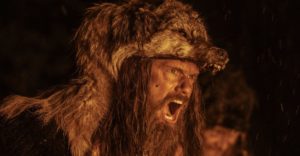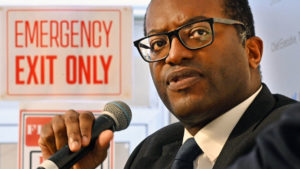The eighth day of June in the Year of Our Lord 793 dawned breezy and bright. On the coast of north-eastern England it seemed a day for strolling along the grassy cliffs and drinking in the sea air; for watching the sea-birds high above, and skimming stones across the green-grey waves; for gazing out at the distant horizon, and wondering what lay beyond.
On the island of Lindisfarne, the monks had been up for hours. Some were bent over their desks, copying the exquisitely illustrated Gospels for which their monastery was famous. Others were working in the kitchens, or cleaning in the chapel, or patiently sweeping the long stone corridors. But on such a fine morning, most of the younger men had slipped outside to work in the gardens. Life out here, two miles off the Northumbrian mainland, was often dark and wet and cold, so it was only sensible to make the most of the sunshine.
Lindisfarne, they all knew, was special, a place like no other. There had been a monastery here for more than a century, a sanctuary from the temptations of the sinful world. In recent months, pilgrims had brought reports of strange signs and omens. Some had talked of whirlwinds, and flashes of lightning, and great fiery dragons soaring through the heavens. But on such a morning as this, when all was well with God’s creation, storms and dragons seemed very far away.
And then one of the younger monks stiffened, and pointed, and gave a cry of warning. His fellows came running to see the sails… and that was the moment everything changed.
What happened that day, as a Viking raiding party rampaged ashore, smashed their way into the church, looted its treasures and carried off shiploads of slaves, has become one of the great milestones in medieval history. The newcomers, wrote one horrified churchman, “poured out the blood of saints around the altar, laid waste to the house of our hope and trampled on the bodies of saints in the temple of God like dung on the streets … Behold, the church of St Cuthbert, splattered with the blood of the priests of God and robbed of all its treasures — the most sacred place in Britain, prey for these wicked heathens!”
Today we remember this as the raid that opened the Viking Age, a 300-year orgy of violence and bloodshed, ambition and adventure, exploration, conquest, romance and horror. The gently embellished version above comes from the opening of my book about this period, Fury of the Vikings, written for children encountering history for the first time. It’s the sixth volume in my Adventures in Time series for younger readers, and judging by the feedback from my school visits, by far the most eagerly awaited.
What it is about the Vikings that fascinates us so much? In the last couple of years, we’ve been treated to the film The Northman as well as the TV shows The Last Kingdom and Vikings. One of the biggest hits this Christmas season is certain to be the video game God of War: Ragnarök — and even if you’re completely indifferent to video games, it’s worth noting that the previous Viking-themed God of War sold a staggering 20 million units at almost £50 apiece. Another, Assassin’s Creed Valhalla, has made more than $1 billion worldwide, more money than all but two of this year’s Hollywood blockbusters. The Vikings, in other words, could scarcely be a bigger draw.
In some ways this might seem a bit of a puzzle, for the Vikings don’t obviously fit into our current cultural moment. Although one or two painfully progressive academics have done their best to reinvent them — open some recent books and you find yourself ploughing through long, earnest paragraphs about their radical attitudes to gender fluidity and hitherto unappreciated enthusiasm for Islamic decoration — the plain fact is that the Vikings were decidedly, outstandingly un-woke.
Indeed, writing my children’s book, I found myself scouring the thesaurus for alternatives to “stabbed”, “smashed”, “crushed” and “splintered”, in a vain attempt to give each episode a different flavour. Severed heads naturally play a central part. “For years to come, Svyatoslav’s gold-plated skull was the chieftain’s favourite wine cup,” reads one random sentence. “The only sound was the drip-drip-drip of blood from the shattered remains of the archbishop’s skull,” reads another. To forestall any talk of the dreaded “sensitivity readers”, I made sure to recite some of these gorier bits to sample audiences and note the reactions. As I’d hoped, the children loved them, except for one little girl who frowned and shook her head. Afterwards she came up to me, still looking very serious. “Not enough beheading,” she said grimly. “More death, please.”
Some people, I know, find all this very unsettling. Visit a Viking exhibition today, and you’re more likely to be lectured about their multicultural trading links and lovely brooch-making than roused by their enthusiasm for ripping people’s eyes out and carrying off thousands of captives. The fact is, though, that violence was at the very heart of the Viking Age, because violence was how they made their all-important silver. And not just violence, by the way, but slavery. Nobody can be sure how many slaves the men of Denmark, Norway and Sweden shipped down the rivers of modern-day Russia and Ukraine to Constantinople and Baghdad between the eighth and eleventh centuries, but the total may well run into the hundreds of thousands. Some historians, such as the University of Uppsala’s Neil Price, talk of the Viking world as a “slave economy”; others have argued that the revival of the entire European economy after the fall of the Western Roman Empire was driven by slavery.
Yet more sensitive readers may be discomfited to learn that children don’t seem to find this a problem at all. Giving talks in primary schools, I’ve often noticed a frankly gleeful look in my listeners’ eyes when I describe terrifyingly tattooed raiders dragging sandal-wearing God-botherers into their longships. And when, a few months ago, I visited the excellent exhibition on the Vikings in the East at Denmark’s Moesgaard Museum, I was struck by the scene at one of the interactive terminals.
The terminal was running a kind of game, inviting children to fill their own Viking longship with a complement of slaves. You could only pack in so many, and you had to choose the captives most likely to fetch a pretty price in the bazaars of the East — a comely young woman here, a strong young man there. Most British or American curators, I imagine, would have a stroke at the very idea. At the very least they’d write an open letter to the Guardian calling for the closure of the museum, the incarceration of its employees and an end to the Tories’ confected culture war. But the kids loved it, openly salivating over the chance to destroy some imaginary villagers’ lives and earn a huge pile of silver dirhams. It was a brilliant way of teaching them how the Viking world worked, although it’s alarming to think that if the slave trade ever does return to the shores of the North Sea, it’ll give the Danes an enormous competitive head start.
What that episode also reminded me, though, is that children don’t like the Vikings despite their bloodthirsty violence. They like the Vikings because of their bloodthirsty violence. For although children can be very sentimental about themselves and about animals, they don’t tend to be sentimental about other people — as anybody who has taken their progeny to an exhibition of medieval torture instruments will tell you. Like the Victorians, we live in an age that romanticises children and seeks to shield them from sights and ideas we consider morally harmful. But embark on a detailed description of some hideous battle, and you’ll soon have your listeners’ eyes shining with delight. “What sort of history do you like best?” I asked one class during a school visit this autumn. “The sort with a lot of fighting,” a little boy said solemnly, to a chorus of approval.
In this respect, are children any different from the rest of us? There’s a reason people watch things like Vikings or The Northman, and it’s not because they’re interested in the rich tradition of Swedish jewellery-making. The Vikings are the last great example of a non-Christian European people to whom turning the other cheek and loving your neighbour sounded like utter gibberish. Their philosophy was almost unrelentingly pessimistic, shot through with an inevitable sense of doom and decline. They saw the world as a dark, cold, cruel place: a place of terrible savagery and dreadful misfortune, where trust was at a premium and betrayal and disaster were never far away, rather like the House of Commons.
Yet they were not nihilists. They thought there was tremendous merit in standing your ground and fighting your corner, sword in hand and a smile on your lips. In one of the most enduring Scandinavian tales, the epic of Ragnar Lodbrok — which inspired the series Vikings — our hero ends up in the Northumbrian king’s snake-pit, the serpents’ venom coursing through his veins. But instead of moaning and groaning about his mental health, Ragnar raises his voice in one last, defiant song. “I am ready to die,” he roars. “The servants of Odin are calling me home. With the gods by my side I shall drink my ale. My days are done; my life is over. Laughing shall I die!” And then he does die. But what a way to bow out!
So perhaps I was wrong, and the Vikings are the perfect fit for our current moment. They, like us, lived in an intensely dangerous, competitive world, where rival warlords struggled for resources. They, like many of us, shook their heads with disbelief at the naïve optimism of their American (or rather, Christian) neighbours, since the Northmen knew life ended only in unspeakable disaster. And they, like us, knew that winter was coming: in their case, the Fimbulwinter, the terrible wolf-winter foreseen by the gods, which would bring the battle of Ragnarök and the end of the world.
They loved tattoos, fancy fashions and stupid haircuts; they liked drinking, having sex and smashing people’s faces in. And the people they really, really hated were pious, hypocritical do-gooders who were always telling them to behave themselves. So they weren’t so different from us, after all.
Dominic Sandbrook’s book Adventures in Time: Fury of the Vikings (Particular Books) is published today.
Disclaimer
Some of the posts we share are controversial and we do not necessarily agree with them in the whole extend. Sometimes we agree with the content or part of it but we do not agree with the narration or language. Nevertheless we find them somehow interesting, valuable and/or informative or we share them, because we strongly believe in freedom of speech, free press and journalism. We strongly encourage you to have a critical approach to all the content, do your own research and analysis to build your own opinion.
We would be glad to have your feedback.
Source: UnHerd Read the original article here: https://unherd.com/




